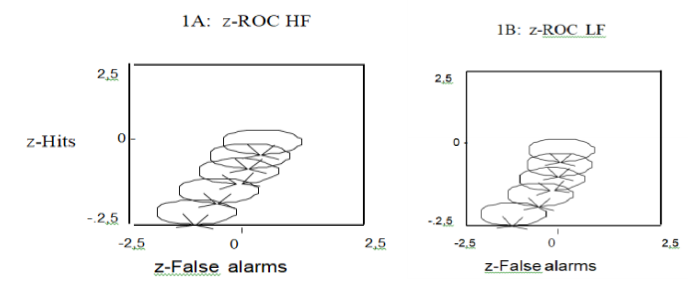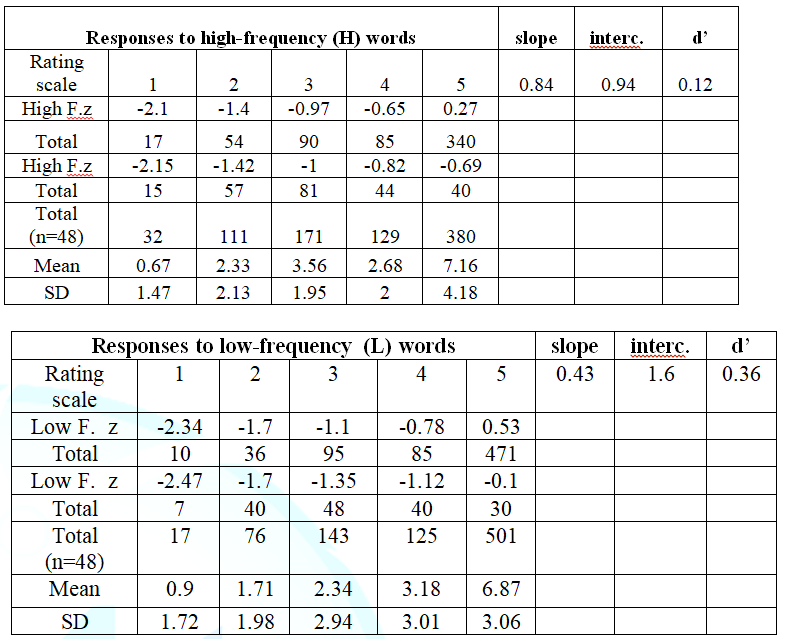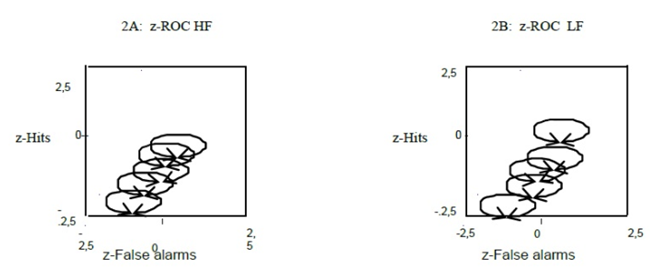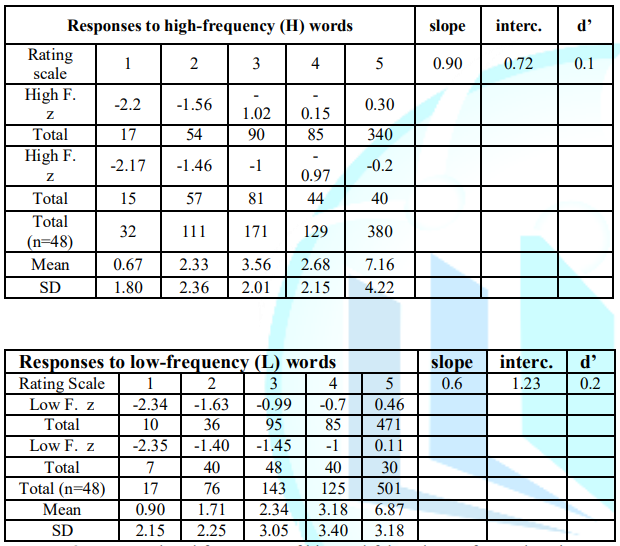Research Article :
Manuel
Pelegrina del Río, Agustín Wallace Ruiz, Maria Concepcion
Moreno Fernandez and Alvaro Pelegrina Fernández Under equivalent experimental conditions, low
frequency words are better recognized than high frequency words. This
phenomenon is known as the word frequency effect in recognition
memory [1]. The word frequency effect is also known as the mirror effect
[2] due to the shape of the response distribution. The frequency of use
(familiarity) is very relevant in the neurological
rehabilitation of language and memory because, according to our general
hypothesis in this work, the recognition of the most frequent words provides
more false alarms than the recognition of infrequent words. In this sense, the present work
represents a formal theoretical model, and a methodology for the generation of
techniques for the rehabilitation of episodic and semantic memory. The words on
reaction times, in this context, are consistent with greater resources of
attention in the processing of less frequent words, but this is not the current
objective of this work. This topic is relevant because
word frequency is the best predictor of performance in recognition memory tasks
[3]. This paper presents a formal model of multi-level responses obtained by
the use of a rating scale and their Receiver
Operating Characteristic (ROC) data [4,5]. The first objective (or general
hypothesis) was to obtain the responses to a recognition memory task and the
scores on the rating scale. These responses can be empirically obtained using
the formal distribution of the stimuli used in the experiment [6]. Thus, the
responses would depend on: where, d is the discrimination
(after correcting for deviation τ), is the signal distribution, and is the noise distribution [7]. The
discrimination index in equation 1 can be re-written as a logit model: where the index d in the equation
1 acquires a value of the logit function: Y represents yes answers to signal S, and c is replaced by the observer´s
criterion. The equivalent equation for noise
is as follows: where, S is replaced by N. From the integration of equations
1, 2 and 3 we obtain: where, the participants response,
at least under criterion c, represents a threshold in the sensorial continuum.
Thus, equation 4 can be transformed into: where, two levels of response are
taken into account. One level is derived from variable X, (or in Signal
Detection Theory (SDT), and the other c from criterion (criterion or
threshold in SDT). This procedure can be generalized by the successive
replacement of elements in order to obtain an equivalent general linear model
[8,9]. where, indicates the probability
of discrimination that depends on the value of parameter αin the variable X as
well as on the parameter β. When all possible responses j in
a rating scale are generalized, the following model is obtained:
where, j is a set of sorted values [7] that can represent the subjects
responses for a given value of X. This procedure provides a general model to
obtain the responses [9], or subjective rating scales [10]. The mathematical models,
presented previously, allow to elaborate formal hypotheses, as well as to
generalize our results for the elaboration of multiple clinical materials for
neurological rehabilitation affected by the word frequency. Our second objective (or general
hypothesis) was to include the responses in the model, which were standardized
(z) through Receiver
Operating Characteristic (z-ROC) data. We obtained the values for intercept
and slope, which are the parameters of a quantitative model, where the slope is
obtained by calculating the ratio between the standard deviations of noise and
signal (σn/σs) and the intercept is the difference between the average
estimations of signal and noise divided by the standard deviations of signal
(µs-µn)/σsn) [11]. The intercept is similar to the equation 1. The ROC distribution described
above allows continuous and threshold distributions to be detected [10]. We
conceptualize continuity as described in Yonelinas and Park. A theory based on
continuity is congruent with the classic model of SDT [12]. Nevertheless,
empirical threshold models provide a better description of changes in memory
level [12]. Hypothetically, these changes are due to sudden changes in
acquisition tendencies due to learning or memorizing. For this reason, despite
SDT being based on the concept of continuity, we assumed that a z-ROC model
would allow us to empirically use both continuous and threshold data and thus
obtain an empirical and unified model of formal analysis. Given the two objectives
described above, we investigated data continuity (non-existence of a threshold)
in the z-ROC data [13]. Data continuity has been investigated in experiments
using hypotheses based on familiarity (e.g., through the presentation of very
frequent stimuli) or on the strength of memory prints, or in experiments using
brief exposure times to stimuli or in experiments on implicit memory [14]. The
notion of a sensory threshold and mathematical models to explain the gradual
nature of observed functions [6]. We hypothesized that nearly linear continuous
z-ROC
data would be obtained in a recognition memory task using HF word lists. In contrast, we hypothesized that
z-ROC data would be discontinuous (non-linear). This hypothesis would be
plausible in experimental designs that allow sufficient conscious processing
time (e.g., >500 ms per word) to produce learning [14]. Our experimental hypothesis
assumed that there would be more false alarms in HF word recognition memory and
fewer false alarms in LF word recognition memory. This hypothetical outcome
would be detected via the different trends in the distribution of the
mathematical functions for each z-ROC data. In effect, the z-ROC data would
show that LF stimuli would cause breaks in continuity in the trend, thereby
producing threshold effects (a U-shaped z-ROC data) suppress, whereas HF
stimuli would be associated with z-ROC
data resembling straight lines. Experiment 1: Laboratory Participants: The experiment included 48 undergraduate students Spanish, monolinguals
who participated voluntarily (21 men and 27 women; age range: 18-26) from the
University of Malaga (Spain). None of the participants had any disease or
disorder that could have affected the experiment. Its control is carried out
through self-report and training test.
Measures: We used frequency dictionaries to assign 80 words,
appendix 1, 40 Low Frequency (LF) words and 40 High Frequency (HF) words) to one
of two experimental conditions [15,16]. The selected words contained 3 to 5
letters and 1 or 2 syllables to control for length. Each set of 40 words was
divided into 20 words randomly assigned as signal words and 20 as noise words.
All other features of the experiment were made constant to avoid affecting the
magnitude of the frequency effect.
Procedure: E-prime was used to
serially present the two word lists, one word at a time [17]. The order of
presentation of the words in each list was randomized for each individual trial
and the order of experimental conditions was counter-balanced for each
participant, thus controlling for primacy and recency effects. The monitors
used, distance to monitor, viewing angle, and researchers present were the same
for all participants. The monitor is a Acer, 15, AL 506 model. The visual
distance to the monitor is 50 cm, and the visual angle is 35º. Verdana letters
of size 14 were used.
All participants underwent training before the trials until they were familiar
with the task. The task consisted in the application of a discrimination
paradigm in recognition memory
based on the SDT model, with YES-NO, plus rating scale answers. Each
participant memorized a list of 20 words in a serial manner, after which said
words were randomly mixed with 20 new words. That is, a list of 40 words. The
participants had to answer YES or NO to each word presented indicating if the
target word had been presented previously (YES answer) or if it was a new word
(NO answer). The words were presented randomly for each participant. The
participants answered verbally and one researcher wrote the answer YES- NO. In
summary, the recognition task consisted in the participants indicating whether
20 previously presented words were present or not in a new list of words that
included the 20 target words (signal) and 20 new words (noise). The
participants gave their responses using an STD-based yes/no format and a
5-point Likert-type scale ranging from 5 (very high confidence in their own
answers) to 1 (very low confidence in their answer). Each word was presented on
screen for 500 ms, and with two seconds of interval between stimuli. To control
for primacy and recency effects in short-term memory, there was a 40-s interval
between presentation and recognition. The participants were asked to respond as
quickly as possible. Analysis: A
one-factor analysis of variance (ANOVA)
was conducted to determine the hits and false alarm rates in each experimental
condition, HF and LF. The corresponding z-ROC data were calculated. Significant differences were found between HF and LF
words in the number of false alarms: ANOVA, F (1, 46) = 4.13, MCE. = 2.34, p =
0.003. The Cohen effect sizes were 0.6. The ANOVA with respect to other variables of SDT model
was not significant. An asymmetric distribution was found in the z-ROC data in
relation to the minor diagonal. Maximum discrimination values for HF words and
LF words were d= 0.12 and d = 0.36, respectively. In addition, the G test was
applied, test showed that the differences were statistically significant, G =
3.75, p = 0.01. There is a significant effect of the word, top-down
processing on false alarms, versus non-significant processing based on the
comparison between the number of syllables of the words (Table 1). Two different z-ROC data
were identified: a relatively straight data for HF words and a relatively
U-shaped data for LF words (Figures 1A and 1B, respectively). The slope was
0.76 and 0.43 for HF words and LF words, respectively, and the intercept was
0.94 for HF words and 1.60 for LF words, respectively. The hit rate was higher
for LF words than for HF words, whereas the false alarm rate was lower for LF
words than for HF words (mirror effect). Table
1 shows the accumulated frequency of hits and false alarms for each point
on the rating scale in the two frequency conditions and the corresponding z-ROC
values (Figure 1 and Table 2). Experiment
1 was replicated in a natural setting to test whether the frequency effect
occurred in the conditions in which academic learning usually takes place. We
expect differences in the results due to contextual variables, but not in reference
to the general hypothesis of this work. The only differences between the two
experiments were the setting. The experiment 2 was done during the regular
class schedule, the number of participants (15 men and 33 women, age range:
18-26) from the University of Malaga (Spain). None of the participants had any
disease or disorder that could have affected the experiment. The 20 signal
words were first presented in a DIN A4 sheet for 6 seconds, which was
proportional to the presentation time in Experiment 1. The 40 words (20 signal
and 20 noise) were then presented in the same format for 12 seconds. The
participants were asked to write, adjacent to each word, whether or not they
recognised it and also completed the 5-point Likert-type rating scale.
Significant differences were too found between HF and LF words in the number of
false alarms: ANOVA, F (1, 46) = 3.71, MCE. = 12, 36, p = 0. 01. The Cohen
effect sizes were 0.45. Maximum discrimination values for HF words and LF words
were d= 0.10 and d = 0.20, respectively. Gourevitch and Galanters
test showed that the differences were statistically significant, G = 2.05,
p = 0.04. As
in experiment 1, the z-ROC data for HF words was relatively straight, whereas
for LF words it was relatively U-shaped (Figures 2A and 2B, respectively). The
hit rate was higher for LF words than for HF words, whereas the false alarm
rate was lower for LF words than for HF words (mirror effect). The slope was
0.90 and 0.57 for HF words and LF words, respectively, and the intercepts were
0.72 and 1.23 for HF words and LF words, respectively (Figure 2 and Table 3). In summary, the ANOVA showed that
there were no statistically significant differences between laboratory and class-room
settings or between some of the basic SDT parameters (hits and false alarms,
ROC data, d, and G test) used to improve the statistical power of the ANOVA.
The results of the experiment in the class-room validate the laboratory
experiment. But different contextual variables in the class-room context
produce more intra experimental variability (Table 3). The trend of the data is observed in the ROC
data, tables and figures previously mentioned. The results of both
experiments confirm the hypothesis that LF words are better discriminated than
HF words and are recognised in a qualitatively different manner. A familiarity
process is indicated by the linear shape of the z-ROC data and HF words. The
other hand, a familiarity process is indicated by the straight line with a
slope which is nearer to one Hence, we assume that LF words are associated with
recollection processes, which is in agreement with model initially proposed by
Yonelinas and Park, whereas familiarity processes are associated with classic SDT
theory [12].
The differences found between HF and LF words in their d values and intercepts
aim in the same direction; together with the formula posed by Cohen [19], they
estimate power and test size, but Cohen effect sizes was greater in the
laboratory experiment. The slope values inversely correlated with d and
intercept. These findings confirm the existence of two different processes: one
for HF words and another for LF words. Furthermore, the hit and false alarm
rates further serve to differentiate between familiarity and threshold response
models, as described by Wickens. A possible explanation for these findings is to
assume that highly familiar stimuli fit into a continuous model, as suggested
by Bröder
& Schütz [20]. Nevertheless, these authors prefer the term strength or
evidence [20] because the term strength has fewer theoretical implications.
Strength is the term traditionally used in word memory studies based on SDT and
the ROC data paradigm, whereas recall is the term suggested by Yonelinas and
Park. Recall would be represented by a high threshold. The model we propose is
consistent with continuous models, such as SDT, that assume that decisions are
based on Bayesian statistics [21]. Signal
Detection Theory uses a priori probabilities of signal and noise as a
technique to analyse responses (signal-noise and hits-false alarms). This
approach is also suitable to analyse classified non-randomized words [22].
Our model suggests that word frequency is coded in the semantic structure of
language and that this coding contributes to the frequency effect observed in
word recognition experiments. Thus, the ideal category (signal) for rapid
cognitive learning would be LF words [23] with a high semantic load (e.g., LF
words with complex or deep meanings). The previous suggestion can be generalized to
heuristic non-linguistic models [24]. We also identified a double dissociation
between stimulus meaning and word
frequency effect, which suggests future lines of research. Our results
support the possibility that HF words may place higher demands on control
processes, although these words are in turn masked and negatively affected by
their higher
frequency [25]. It has been found that naming latencies for homophones are
indistinguishable from those for non-homophone controls matched on
word-specific frequency [26]. In a different setting, these results support our
initial hypothesis on the frequency effect extended not only to the setting of
recognition memory, but also to the setting of speech
production. Others researchers have also suggested a shared
simple and dual processing model [27], but only as an experimental model in a
lexical context in which word frequency affects the connections between the
orthographic lexicon and phonologic lexicon [28]. These findings point to new
directions in research and in the formalization of models. A general memory model should include the
distribution of all the possible responses obtained [10] and their assessment
via suitable mathematical distributions (e.g., ROC
data), which would allow the results (or responses) of other models to be
included in the general memory model. The substantive theory would be based on
a general memory model that uses classified stimuli (according to frequency of
use in this study); its results would oscillate on a continuum between two
points: random recognition and fully aware recognition. This continuum is
affected by numerous complex variables, many of which remain to be identified.
Is an example of these types of variable the additive effects of stimulus
quality and word frequency [29]. However, future research we have to considerer
the relationship between frequency and transparency of the words, for example:
the interaction between transparency and base frequency comes from targets that
adequately represent the entire spectrum of transparency [30]. It should be
noted that the transparency by base frequency interaction is consistent with a
distributed connectionist framework [31]. Another relevant variable is the time
in years, effectively the variable frequency changes in relation to the time in
different ways [32] or the colour vision on the Alzheimer deficiencies in Alzheimers
disease [33] and in medical decision methods [34]. 5.
Goldstein
H. (1995) Multilevel Statistical Models (2nded) Edward Arnold,
London. 10.
Pelegrina
M, Wallace A, Emberley E, and Marín R. ROC and z-ROC analyses in recognition
memory: continuous, threshold and assymetric models (2011) Psicothema
23:845-850. 12.
Green
D M and Swets JA. Signal detection theory and psychophysics (1989) John Wiley
and Sons Inc, New York. 14.
Pelegrina
M, Wallace A, Vívar C, Moreno MC and Seguel J. Evoked potentials (P300, N400 i
N200) and ROC and SDT parameters applied to implicit components of memory
(2014) Anuari de Psicologia 15:93-112. 15.
Juiland
A and Chang-Rodríguez E. Frequency dictionary of Spanish words (1966) Mouton
& Company, La Haya. 16.
Alameda
JR and Cuetos F. Frequency dictionary for linguistic units in Spanish] (1995) Universidad,
Oviedo. 17.
Schneider
W, Eschman A and Zuccolotto A. E-Prime reference guide. Psychology Software
Tools Inc, Pittsburgh. 18.
Glanzer
M, Hilford A and Kim K. Six regularities of source recognition. Journal of
Experimental Psychology: Learning, Memory, and Cognition (2004) 30:1176-1195. 23.
Kim
SW and Murphy GL. Ideals and category typicality. J Exp Psycholo: Learning,
Memory, and Cognition (2012) 37: 1092-2112. 24.
Erdfelder
E, Küpper-Tetzel CE and Mattern SD. Threshold models of recognition and the
recognition heuristic (2011) Judgment and Decision Making 6:7-22. 28.
Peressotti
F and Colombo L. Reading aloud pseudo homophones in Italian: Always an advantage.
Memory and Cognition (2012) 40:466-482. 29.
Liu
P, Li X and Han B. Additive effects of stimulus quality and word frequency on
eye movements during Chinese reading (2015) Reading and Writing 28:199-215. 33.
Buil
S, Cuba J, Ríos R and Pelegrina M. Efectos del color en el tiempo de latencia
en enfermos de Alzheimer en fase grave (2017) Neurama Revista Electrónica de
Psicogerontología. Manuel Pelegrina del Río, Department
of Psychobiology and Methodology, Faculty of psychology, Malaga university,
Malaga, Spain, Tel: 952132538, E-mail: pelegrina@uma.es
Pelegrina
del Río M, Ruiz AW, Fernandez MCM and Fernández AP. ROC modelling data of the
word frequency effect: A formal model of visual word recognition (2019)
Neurophysio & Rehab 2: 1-5 Modelling, Memory, Frequency, WordsROC Modelling Data of the Word Frequency Effect: A Formal Model of Visual Word Recognition
Abstract
This article presents a
formal statistical model for assessing the word frequency effect in recognition
memory. This topic is relevant because word frequency is the best predictor of
performance in recognition memory tasks. Signal Detection Theory was applied
using high-frequency and low-frequency words as item-signals. Signal Detection
Theory test assumes orthogonality of responses: hits, false alarms, correct
rejections, and incorrect rejections. Ninety-six adult male and female students
participated in two experiments: one conducted in the laboratory and the other
in the class-room. The selected words for memory contained 3 to 5 letters and 1
or 2 syllables to control for length. Significant differences were found
between high-frequency and low-frequency words in the number of false alarms
for the two experiments. The differences were statistically significant in two
experiments. The Cohen effect size was 0.6 and 0.45 respectively. The word
frequency effect in first- and second-experiments was F (1, 46) = 4.13, MCE. =
2.34, p = 0.003 and F (1, 46) = 3.71, MCE. = 12.36, p = 0. 01 respectively. A
formal model is presented based on the Receiver Operating Characteristic data
to assess data trends for high- and low frequency words. Two differentiated
models were obtained: a continuous model based on high frequency stimuli and a
threshold model based on low frequency stimuli.
Full-Text
Introduction
Material and Methods
Results



Experiment
2: Class-room
Results


Discussion
References
*Corresponding
author
Citation
Keywords